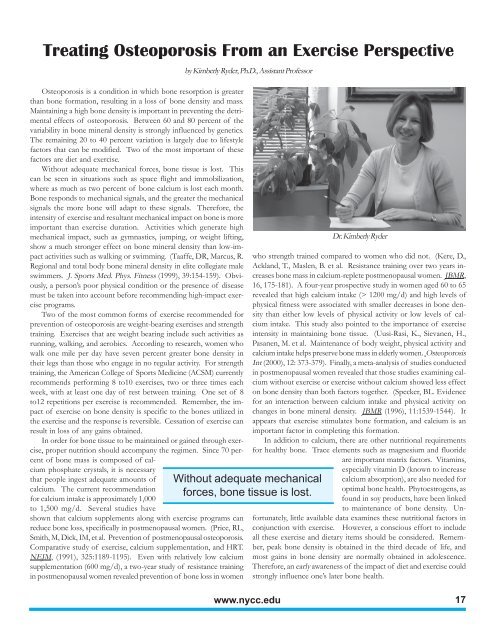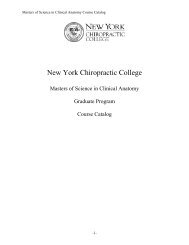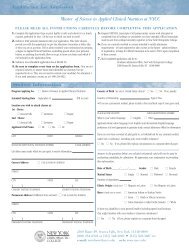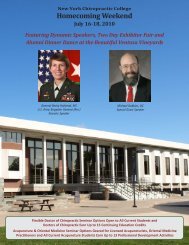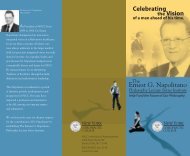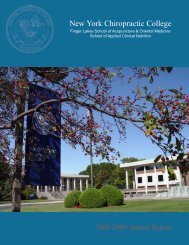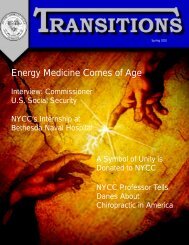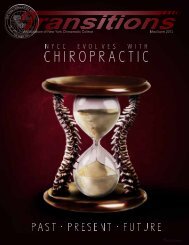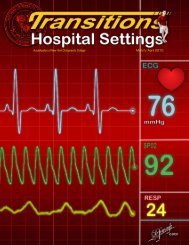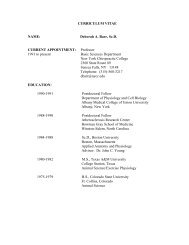2502 NYCC TRANS FINAL2 - New York Chiropractic College
2502 NYCC TRANS FINAL2 - New York Chiropractic College
2502 NYCC TRANS FINAL2 - New York Chiropractic College
Create successful ePaper yourself
Turn your PDF publications into a flip-book with our unique Google optimized e-Paper software.
Treating Osteoporosis From an Exercise Perspective<br />
Osteoporosis is a condition in which bone resorption is greater<br />
than bone formation, resulting in a loss of bone density and mass.<br />
Maintaining a high bone density is important in preventing the detrimental<br />
effects of osteoporosis. Between 60 and 80 percent of the<br />
variability in bone mineral density is strongly influenced by genetics.<br />
The remaining 20 to 40 percent variation is largely due to lifestyle<br />
factors that can be modified. Two of the most important of these<br />
factors are diet and exercise.<br />
Without adequate mechanical forces, bone tissue is lost. This<br />
can be seen in situations such as space flight and immobilization,<br />
where as much as two percent of bone calcium is lost each month.<br />
Bone responds to mechanical signals, and the greater the mechanical<br />
signals the more bone will adapt to these signals. Therefore, the<br />
intensity of exercise and resultant mechanical impact on bone is more<br />
important than exercise duration. Activities which generate high<br />
mechanical impact, such as gymnastics, jumping, or weight lifting,<br />
show a much stronger effect on bone mineral density than low-impact<br />
activities such as walking or swimming. (Taaffe, DR, Marcus, R.<br />
Regional and total body bone mineral density in elite collegiate male<br />
swimmers. J. Sports Med. Phys. Fitness (1999), 39:154-159). Obviously,<br />
a person’s poor physical condition or the presence of disease<br />
must be taken into account before recommending high-impact exercise<br />
programs.<br />
Two of the most common forms of exercise recommended for<br />
prevention of osteoporosis are weight-bearing exercises and strength<br />
training. Exercises that are weight bearing include such activities as<br />
running, walking, and aerobics. According to research, women who<br />
walk one mile per day have seven percent greater bone density in<br />
their legs than those who engage in no regular activity. For strength<br />
training, the American <strong>College</strong> of Sports Medicine (ACSM) currently<br />
recommends performing 8 to10 exercises, two or three times each<br />
week, with at least one day of rest between training. One set of 8<br />
to12 repetitions per exercise is recommended. Remember, the impact<br />
of exercise on bone density is specific to the bones utilized in<br />
the exercise and the response is reversible. Cessation of exercise can<br />
result in loss of any gains obtained.<br />
In order for bone tissue to be maintained or gained through exercise,<br />
proper nutrition should accompany the regimen. Since 70 percent<br />
of bone mass is composed of calcium<br />
phosphate crystals, it is necessary<br />
that people ingest adequate amounts of<br />
calcium. The current recommendation<br />
for calcium intake is approximately 1,000<br />
to 1,500 mg/d. Several studies have<br />
shown that calcium supplements along with exercise programs can<br />
reduce bone loss, specifically in postmenopausal women. (Price, RL,<br />
Smith, M, Dick, IM, et al. Prevention of postmenopausal osteoporosis.<br />
Comparative study of exercise, calcium supplementation, and HRT.<br />
NEJM, (1991), 325:1189-1195). Even with relatively low calcium<br />
supplementation (600 mg/d), a two-year study of resistance training<br />
in postmenopausal women revealed prevention of bone loss in women<br />
by Kimberly Ryder, Ph.D., Assistant Professor<br />
Without adequate mechanical<br />
forces, bone tissue is lost.<br />
Dr. Kimberly Ryder<br />
who strength trained compared to women who did not. (Kere, D.,<br />
Ackland, T., Maslen, B. et al. Resistance training over two years increases<br />
bone mass in calcium-replete postmenopausal women. JBMR,<br />
16, 175-181). A four-year prospective study in women aged 60 to 65<br />
revealed that high calcium intake (> 1200 mg/d) and high levels of<br />
physical fitness were associated with smaller decreases in bone density<br />
than either low levels of physical activity or low levels of calcium<br />
intake. This study also pointed to the importance of exercise<br />
intensity in maintaining bone tissue. (Uusi-Rasi, K., Sievanen, H.,<br />
Pasanen, M. et al. Maintenance of body weight, physical activity and<br />
calcium intake helps preserve bone mass in elderly women. Osteoporosis<br />
Int (2000), 12: 373-379). Finally, a meta-analysis of studies conducted<br />
in postmenopausal women revealed that those studies examining calcium<br />
without exercise or exercise without calcium showed less effect<br />
on bone density than both factors together. (Specker, BL. Evidence<br />
for an interaction between calcium intake and physical activity on<br />
changes in bone mineral density. JBMR (1996), 11:1539-1544). It<br />
appears that exercise stimulates bone formation, and calcium is an<br />
important factor in completing this formation.<br />
In addition to calcium, there are other nutritional requirements<br />
for healthy bone. Trace elements such as magnesium and fluoride<br />
are important matrix factors. Vitamins,<br />
especially vitamin D (known to increase<br />
calcium absorption), are also needed for<br />
optimal bone health. Phytoestrogens, as<br />
found in soy products, have been linked<br />
to maintenance of bone density. Unfortunately,<br />
little available data examines these nutritional factors in<br />
conjunction with exercise. However, a conscious effort to include<br />
all these exercise and dietary items should be considered. Remember,<br />
peak bone density is obtained in the third decade of life, and<br />
most gains in bone density are normally obtained in adolescence.<br />
Therefore, an early awareness of the impact of diet and exercise could<br />
strongly influence one’s later bone health.<br />
www.nycc.edu<br />
17


